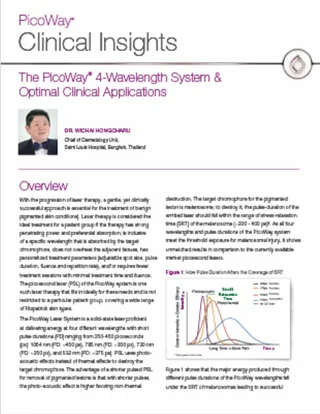PicoWay® 4-wavelength system and optimal clinical applications
According to Dr. Wichai's white paper, laser therapy is considered to be one of the ideal treatment when the treatment has strong penetrating power and preferential absorption; is inclusive of a specific wavelength that is absorbed by the target chromophore, does not overheat the adjacent tissues, has personalized treatment parameters (adjustable spot size, pulse duration, fluence and repetition rate), and/or requires fewer treatment sessions with minimal treatment time and fluence.
The picosecond laser (PSL) of the PicoWay system offers one such laser therapy that fits in ideally for these needs and is not restricted to a particular patient group, covering a wide range of Fitzpatrick skin types.
Dr. Wichai provides clinical insights on using all PicoWay handpieces and here are the takeaways included in this paper:
- Overview of all 4 wavelengths
- Clinical applications on:
- The PicoWay Zoom Handpiece: 1064 nm and 532 nm
- The PicoWay 785 nm (or 300 ps) Handpiece
- The PicoWay 730 nm (or 250 ps) Handpiece
- The PicoWay Resolve Fractional Handpiece
- Practical considerations for pulse duration and fluence selection
About Dr. Wichai Hongcharu
Dr. Hongcharu is the Chief of Dermatology Unit of Saint Louis Hospital, Bangkok, Thailand. He received both certificates of Clinical Fellowship in Dermatology and Research Fellowship in Laser and Photo Medicine respectively from Harvard and the Department of Energy in USA. Also, he was awarded diplomas in both Internal Medicine and Dermatology from the University of London. Now he is an Associate Member of the American Society of Laser Medicine and Surgery.
He received his M.D. degree from Chulalongkorn University. From 1993-1995, he had his dermatology training at the Hammersmith Hospital and also received a Diploma in Dermatology from the St. John’s Institute of Dermatology, London. After his training in the United Kingdom, he was recruited into the Harvard Scholars Program from 1997-2000. During his clinical fellowship at Harvard, he had an opportunity to work with Dr. Rox Anderson at Wellman Laboratories of Photomedicine and received a research grant from the Department of Energy, USA to study photodynamic therapy and laser medicine.
His publication “Topical ALA-Photodynamic Therapy for The Treatment of Acne Vulgaris” in Journal Investigate of Dermatology has great impacts on light-based therapy for acne.
Dr. Hongcharu also practices dermatology, teaches at Mae Fah Luang University, and conducts research in new coming photomedicine.
 Japan
Japan Korea
Korea China
China
